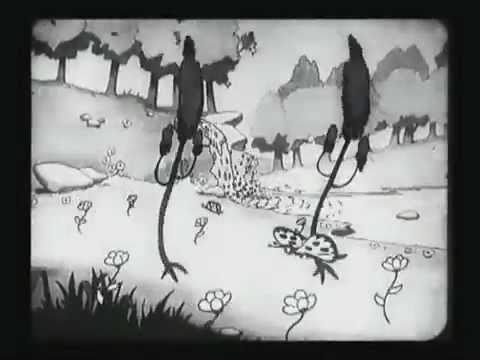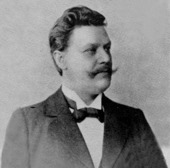One month after the release of El Terrible Toreador, Disney released its third Silly Symphony. Titled Springtime, it received immediate praise with The Film Daily declaring, “This is called a Disney Silly Symphony, and it is a corker. The cartoon work is about the best that has ever been seen in the animated field, the expressions and general antics of the animals being unusually clever as well as true to life.” Variety was equally effusive in its praise, declaring, “In Springtime Disney has sought to express that vernal feeling of animated insect, animal and flower characters in novel dance routines set to intriguing musical numbers. Timing of the dances, the accompanying taps, etc., is so perfect that the rhythm alone imparts rare entertainment value to this new one in the Silly Symphony series. Every opportunity to inject comedy for laughs has also been seized.”
In terms of plot, the short has more in common with The Skeleton Dance than its immediate predecessor, which is to say that there’s no real plot to speak of. Though the plot of El Terrible Toreador was fairly thin, it at least hinted at the story of Bizet’s Carmen. In contrast, and like The Skeleton Dance, Springtime was more evocative of a mood and a moment in time than a true story. While The Skeleton Dance suggested the events of a dark October night, Springtime evokes the season it was named after.
Morning Mood
The film opens with an idyllic scene. Trees and flowers are dancing in a field while butterflies flit about. In the background, a waterfall feeds into a stream. In the background, we hear the sound of birds chirping mixed with the opening strains of Edvard Grieg’s “Morning Mood.”

The film marked the second time in three cartoons that Carl Stalling and the Silly Symphony team at Disney had used the music of Grieg. His “The March of the Dwarfs” provided the soundtrack to The Skeleton Dance earlier in the year.
The song “Morning Mood” was written as part of Grieg’s work composing music for his friend Henrik Ibsen’s five-act play Peer Gynt (which was written in verse). While Grieg was honored to take part in the project, he found it particularly challenging, telling a friend, “Peer Gynt progresses slowly and there is no possibility of having it finished by autumn. It is a terribly unmanageable subject.”
The work seemed to affect him deeply, and his wife noted, “the more he saturated his mind with the powerful poem, the more clearly he saw that he was the right man for a work of such witchery and so permeated with the Norwegian spirit.”

“Morning Mood” was written for the fourth scene of act four which finds the play’s titular character stranded in the desert in Morocco. Speaking of the piece, Grieg visualized, “the sun breaking through the clouds at the first forte.” As noted in the liner notes for Naxos’s release of the music, “This produces an unusual musical form: the climax comes early on, and the day then settles down to rest. Towards the end we hear imitations of birdsong. The incessant flowing figures suggest associations with waves on the seashore, or with wind. Or they could be sounds in Peer Gynt’s head. Grieg asked that the piece ‘be treated as pure music’, and as such it has a unique place in the drama.”
The piece is used for no more than a few seconds in Springtime, just long enough to evoke the feeling of a new day before the music gives way to Franz von Blon’s “Whispering Flowers (Blumengeflüster).”
Whispering Flowers
With the idylls of the new day past, the plants and animals set about their daily activities. It starts innocently enough, with a trio of flowers dancing across the screen in unison and a pair of ladybugs dancing together atop an open flower. We then see a caterpillar hopping and dancing along the ground, until he is somewhat unceremoniously eaten piece by piece by a crow in a stovepipe hat.

This dynamic plays out through the remainder of the short, with animals enjoying a peaceful and charming life out in the wild only to be promptly devoured by a predator who then goes about it’s own day, enjoying the beauty and freshness of a spring morning, all while Blon’s jaunty melody plays in the background.
Born in Berlin, Germany in 1861, Blon began playing the violin at a young age and attended Stern’s Conservatory of Music. It was a great testament ot his skill, and he was one of only 6 students accepted out of 123 who applied.

From 1880-1883, he fulfilled his military obligations as part of the 12th Infantry Regiment at Frankfurt. It was during this time that he began composing. He would later become konzertmaster at the Hamburg Municipal Theatre before founding the Berlin Philharmonic Wind Orchestra. The group became quite famous, and he toured with them internationally, including a performance at the 1904 St. Louis World’s Fair.

While he was primarily known for composing marches, he did create other pieces of music, including “Whispering Flowers (Blumengeflüster).” The piece was first published in 1894 and alternates between moments of slow, serene beauty and an uptempo, playful melody. It’s a perfect compliment for the onscreen action.
Offenbach and Beyond
In addition to the work of von Blon and Grieg, Springtime also features music by Amilcare Ponchielli (who would also be featured in Disney’s 1940 animated masterpiece Fantasia).
Next week, we’ll wrap up our dive into Springtime by taking a look at Ponchielli’s contributions to the piece.